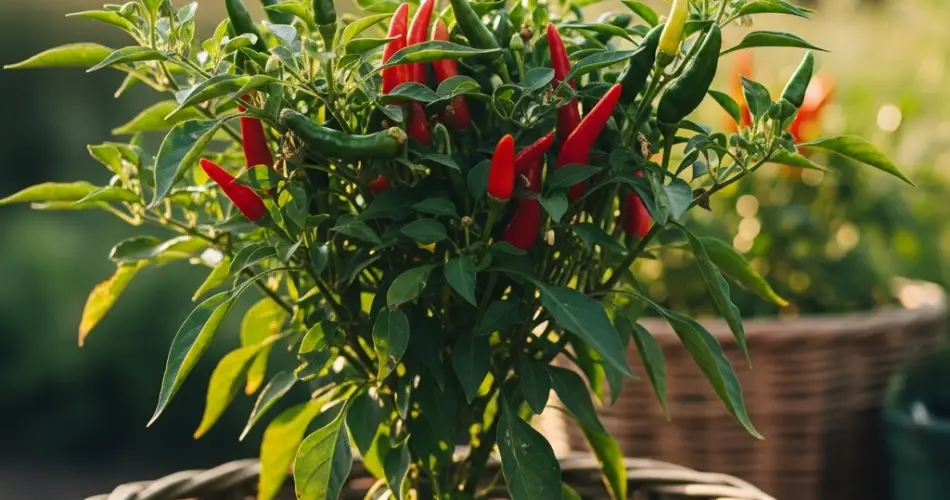Hot peppers are a favorite among gardeners for their vibrant colors, unique flavors, and versatility in cooking. From spicy salsas to pickled treats, homegrown peppers add zest and nutrition to meals. For urban gardeners or those with limited outdoor space, woven baskets offer an ideal solution for cultivating fresh hot peppers. Basket gardening allows for controlled soil conditions, easy harvesting, and aesthetic appeal, while also enabling continuous fruit production throughout the growing season. With proper care, soil preparation, and planting techniques, gardeners can enjoy a bountiful harvest of fresh hot peppers.
Why Woven Baskets Work for Hot Peppers
Hot peppers are compact plants with moderate root systems, making them well-suited for container gardening. Woven baskets offer several advantages:
-
Space Efficiency – Perfect for balconies, patios, or small urban gardens where traditional ground planting is not possible.
-
Improved Drainage – Woven containers allow excess water to escape, reducing the risk of root rot.
-
Mobility – Baskets can be moved to optimize sunlight exposure or protect plants from extreme weather.
-
Aesthetic Appeal – Woven baskets provide a decorative element to your garden while producing nutritious peppers.
Choosing the Right Woven Basket
Select a basket at least 10–12 inches deep with a diameter of 12–16 inches per pepper plant. Adequate depth allows the root system to develop fully, while a wider basket provides sufficient soil volume to retain moisture and nutrients. Ensure the basket has proper drainage holes to prevent waterlogging. If the weave is too porous, line the basket with breathable materials such as coconut coir or burlap to hold the soil in place. Sturdy handles or reinforced sides are important for safely moving the basket when filled with soil and growing plants.
Preparing the Best Soil Mix
Hot peppers thrive in loose, nutrient-rich soil that drains well while retaining enough moisture to support growth. A well-prepared soil mix encourages strong roots, abundant flowering, and healthy fruit production. A recommended mix for woven baskets includes:
-
40% Organic Compost – Provides essential nutrients and enhances soil fertility.
-
30% Loamy Garden Soil – Adds minerals and stability for root development.
-
20% Coconut Coir or Peat Moss – Retains moisture without compacting the soil.
-
10% Perlite or Vermiculite – Improves drainage and aeration, preventing waterlogging.
Mix these ingredients thoroughly to create a light, airy medium that encourages healthy root growth and supports sustained fruiting.
Planting Hot Peppers
Start with healthy seedlings or transplants for best results. Plant one pepper per basket to avoid overcrowding, spacing each plant evenly within the container. Hot peppers can also be grown from seeds indoors before transplanting once seedlings are strong enough. Ensure that the plant is placed slightly deeper than it was in its nursery container to support stable growth.
Sunlight and Watering Requirements
Hot peppers require full sun to thrive, ideally 6–8 hours of direct sunlight per day. If natural light is limited, consider moving the basket or supplementing with grow lights to ensure proper flowering and fruiting.
Consistent watering is essential for peppers. Keep the soil evenly moist but not waterlogged, as overwatering can lead to root rot and other issues. Baskets tend to dry out more quickly than garden beds, so check soil moisture regularly, especially during hot or windy conditions. Avoid wetting the leaves to minimize the risk of fungal diseases.
Fertilization for Maximum Yield
While compost provides essential nutrients, additional feeding encourages strong growth and continuous fruiting. Use a balanced, water-soluble fertilizer or organic options such as fish emulsion every two to three weeks. Avoid excessive nitrogen, which promotes leafy growth rather than fruit production. Fertilization supports healthy flowering, vibrant color, and rich flavor in the peppers.
Harvesting Hot Peppers
Hot peppers are ready to harvest when they reach the desired color and size for the variety grown. Regular harvesting encourages the plant to produce new flowers and fruits, ensuring continuous yields throughout the season. Handle peppers gently when picking to avoid damaging stems or other developing fruits. Succession planting can also help maintain a steady supply if you plan to harvest over an extended period.
Common Challenges and Troubleshooting
-
Pests – Aphids, spider mites, and pepper weevils can affect plants. Use organic sprays or companion planting to manage infestations.
-
Diseases – Fungal infections such as powdery mildew may appear. Ensure good airflow, proper spacing, and avoid overhead watering.
-
Poor Fruit Development – Can result from insufficient sunlight, nutrient deficiencies, or inconsistent watering. Adjust care practices as needed to promote healthy growth.
Conclusion
Growing hot peppers in woven baskets is a convenient, attractive, and productive way to enjoy fresh, homegrown peppers even in limited spaces. By choosing appropriate baskets, preparing nutrient-rich soil, providing consistent water and sunlight, and maintaining regular fertilization, gardeners can achieve continuous harvests throughout the season. Basket-grown peppers transform small outdoor areas into vibrant, productive gardens, offering the satisfaction of cultivating flavorful, nutritious vegetables right at your fingertips.



